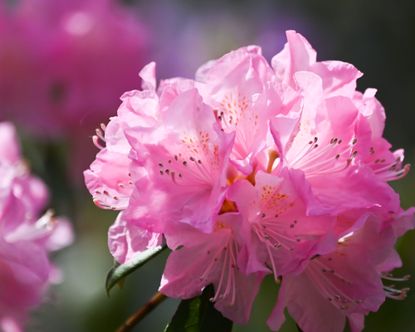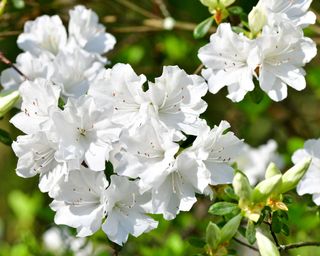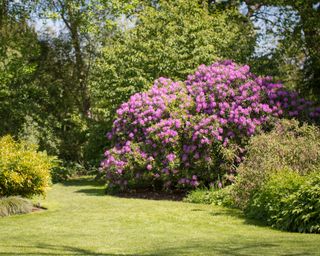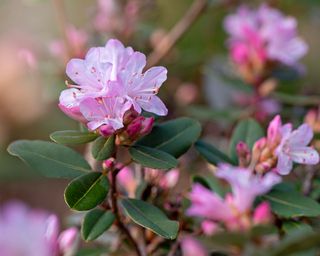How to grow azaleas – for showy spring color
Indulge in some spectacular early season color and learn how to grow azaleas


Discovering how to grow azaleas is a great way to fill your backyard with early spring color. Long a stalwart of ornamental woodland gardens and borders, these long-lived and easy-care beauties have many avid fans.
Natalie Hoare owner of the renowned Japanese Garden in St Mawgan, Cornwall says, ‘azaleas come a little later than traditional cherry blossom and tend to stay for longer, offering a wonderful variety of color to the garden as we enter spring and summer.’
Azaleas make for a stunning addition to your flower bed ideas. Smothered in vibrant star-shaped blooms in every shade from pink, orange, red and yellow, these shrubs are also deliciously scented. Flower shapes do vary slightly, while most varieties have a single layer of petals a few produce complex hose-in-hose double blooms where one flower appears to sit inside another.
Azaleas originate from Turkey, Asia and South America. Sharing many characteristics, these smaller leaved shrubs have recently been recategorized as belonging to the Rhododendron genus, but many nurseries and retailers still list them as azaleas for ease. It’s worth knowing that azaleas have five or six stamens in the center of their blooms while rhododendron usually have 10 or more.
Knowing when to plant azaleas and how to prune azaleas will of course get you the best results in terms of flowering, too; we have separate guides for these questions. Here, though, we tell you everything you need to know about growing azaleas.
How to grow azaleas
Learning when to plant azaleas will help you raise strong, disease-resistant plants. They are also pretty specific when it comes to their ideal soil and growing conditions, so do read on to find out more about their likes and dislikes so you can grow them with confidence.

What different types of azalea are there?
There are two distinct types of azaleas. Evergreen or Japanese azaleas tend to be smaller, slow growing with small, pointed leaves that turn vibrant shades in fall. Reaching only 3ft (90cm) high in ten years, they are perfect for growing in containers.
Deciduous azaleas are much taller. Growing up to 4-5ft (120-150cm) high in ten years they make a stunning statement in a border or on the edge of a woodland area. Their flowering period is from May to July, but their foliage puts on a stunning fall display just before the leaves drop. These fast-growing plants tend to be much hardier than their evergreen cousins.
Where to plant an azalea
These decorative plants tend to prefer a spot in full sun or dappled shade. Particularly suited to growing in a woodland border or in a pot, they are great for adding structure, attractive glossy foliage and of course a burst of vivid color during spring and early summer. Evergreen varieties do prefer a shadier spot as strong, full sun can scorch the leaves and delicate flowers.
Many dwarf Japanese and bi-colored varieties also make stunning container features. Just make sure the container has large drainage holes and the soil is kept moist. These plants find it hard to recover once their roots have totally dried out and can succumb more easily during winter frosts.
What soil type do azaleas prefer?
‘The trick to growing azaleas successfully is to get the correct soil pH level,’ says Angharad James, product manager at Phostrogen. ‘Azaleas are a member of the ericaceous family, meaning they prefer a more acidic soil to other plants. Identify what type of soil you have and how acidic the soil is using a pH tester. Acidity is measured using the pH scale which uses a scale between 1-14 – the lower the pH, the more acidic something is, the higher the more alkaline. A reading below 7 is considered acidic and above 7 is considered alkaline, while 7 itself is neutral.’
If your soil is not naturally acidic you can either enrich it using ericaceous compost or use a specialist ericaceous plant food. Containing added iron and sulphur, these will help the plant to produce more blooms and keep foliage green and healthy. A layer of leaf mould will also help boost acidity levels.

How to nurture an azalea
When it comes to keeping your Azaleas strong and healthy there are a few points worth bearing in mind. Mulching yearly with a layer of pine bark is a good way of fertilizing azaleas and will help retain moisture and suppress weeds while still maintaining vital acid levels, and this is particularly important if your shrubs are planted in a bright and sunny spot.
Azaleas generally need very little care and pruning but occasionally you may need to cut out a dead branch or reshape the shrub. This is best done once flowering is over. Re-blooming varieties can also benefit from a light trim to aid a second flush of flowers. Deadheading is also recommended to keep the plant looking tidy and to promote healthy growth.
Late spring frosts can damage young shoots and buds, sometimes severely, resulting in the loss of that season’s flowers. To prevent this, it is worth wrapping the shrub in protective horticultural fleece until milder weather returns. There are some azalea diseases to be aware of, but good cultural techniques such as proper planting, spacing, and watering all help combat these fungal problems.
How to grow an azalea in a pot
Azaleas make a stunning statement grown in a container with the added benefit that you can move them around according to the amount of sun or shade need and whether or not they are in flower. It’s also an easy option if the soil in your yard is naturally pH neutral or alkaline, as you can simply use ericaceous compost which provides all the nutrients the plant needs.
Select a container with good drainage and that measures around 4 inches (10cm) less in diameter than the plant’s leaf spread or canopy. This will ensure that the compost and roots will not get too wet during rainy periods.
Line the base with drainage crocks and a few small pine bark chips to encourage root growth to spread, before topping up with ericaceous soil.
Azaleas are shallow rooted and wide spreading, and they prefer their root ball to be just below the soil’s surface. Bear this in mind when placing the plant in a new container. Aim to sit the root ball an inch below the top of the pot and fill around the edges with compost, firming lightly.
‘The next step is to put a layer of 4-5cm of pine bark chips on top to finish off the pot,’ says Will Murch of azalea experts, Osberton Nurseries. ‘As well as looking really smart they keep the roots cool, aerate the soil, keep moisture in and stop weeds from growing. it is important to pull these 2 or 3cm away from the point where the plant's stem joins the compost to stop it getting too moist.’
Water well, ideally using rainwater rather than mains or tap water which can contain high levels of lime.

Where do azaleas grow best?
‘Flower buds on spring-blooming azaleas form long before winter. Choosing types that withstand your winter temperatures is essential to spring blooms. Many azaleas are only bud-hardy in the country's southern half, but some northern-bred types can withstand minus 45 degrees Fahrenheit. Your county extension agent can help with zone information and tips on plants that will thrive,’ says the team at Pennington Seed Inc.
Do azaleas like sun or shade?
Azaleas prefer around 6-8 hours of sun a day or dappled rather than dense shade. Different varieties have different needs but evergreen or Japanese azaleas tend to prefer semi shade while deciduous types copy better with a sunny spot.
Sign up to the Homes & Gardens newsletter
Decor Ideas. Project Inspiration. Expert Advice. Delivered to your inbox.

Jill Morgan has spent the last 20 years writing for Interior and Gardening magazines both in print and online. Titles she has been lucky enough to work on include House Beautiful, The English
Home, Ideal Home, Modern Gardens and Gardeningetc.com. Although much of her career has involved commissioning and writing about reader homes and home improvement projects, her
everlasting passion is for gardens and outdoor living, which is what she writes about for Homes & Gardens.
-
 Get 45% off De'Longhi, Nespresso, and more in Bloomingdale'sblo coffee maker sale – these are the deals that will sell out fast
Get 45% off De'Longhi, Nespresso, and more in Bloomingdale'sblo coffee maker sale – these are the deals that will sell out fastWe asked a barista to pick the best coffee maker deals on offer in Bloomingdale's sale. They found discounts on De'Longhi, Nespresso, and more
By Laura Honey Published
-
 Moccamaster has made 2,000 diamond edition coffee makers – here's how to get your hands on one
Moccamaster has made 2,000 diamond edition coffee makers – here's how to get your hands on oneTechnivorm Moccamaster has launched a limited edition diamond version of the KGBV Select. One of the best drip coffee makers on the market just got even more special
By Laura Honey Published